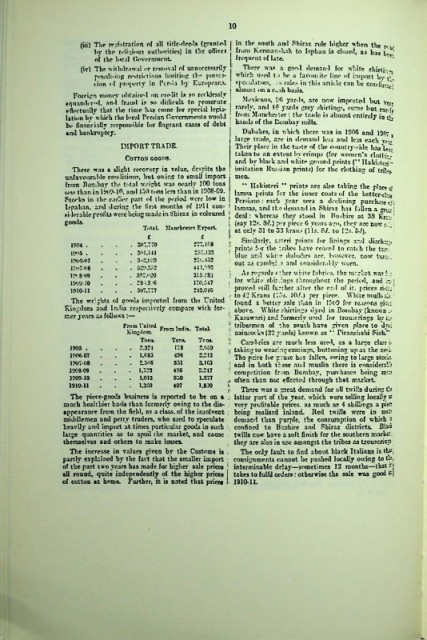Page 282 - 5 Persian Trade rep BUSHIRE I_Neat
P. 282
10
(iii) The registration of all title-deeds (granted in the south and Shiraz rule higher when the r r
by the roliuious authorities) in the offices from Kerman-hah to Isphan is closed, as has l,*['
of the loc.il Government. frequent of late. '*•
(iv) The withdrawal or removal of unnecessarily There was a good demand for white ehirtia-n
penalising restrictions limiting the posses- which used t • he a favourite line of import by .1.
non ,.f property in Persia l»y Europeans. speculators, :s sales in this article can be condijcJ-'
nliuoit on a Cwsh basis.
Foreign money obtained on credit is so recklessly
squander*!, and fraud is so difficult to prosecute Mexicans, t*G yards, are now imported but ver*
effectually that the time has come for special Icpis- rarely, and 1? yards grey shirtings, come but rardr
lation by which the local Persian Governments would from Manchester: the trade is almost entirely in tVt
be financially responsible for flagrant cases of debt hands of the Bombay mills.
and bankruptcy. Dubalirs, in which there was in 1906 and 19rq
large trade, are in demand less and less each vn.
IMPORT TRADE. Their place in the taste of the country-side has t#*,
taken to an extent by crimps (for women’s cloth}- .'
Cotton goods.
and by black and white ground prints ('* Hakisteri"
There was a slight recovery in value, despite the imitation Russian prints) for the clothing of triby.
unfavourable conditions, but owing to small import men.
from Bombay the total weight was nearly 100 tons " Ilakisteri ** prints arc also taking the place rj
than in 1W9-10, and 130 tons loss than in 1908-09.
less lamsa prints for the inner coats of the bet ter-ch^
Stocks in the earlier part of the period wore low in Persians: each year sees a declining purchase <-•;
Ispahan, and during the first months of lVll con- ' |arnsas, and the demand in Shiraz has fallen a «ru:l
sidcrablc profits were being made in Shiraz in coloured j deal: whereas they stood in Rushirc at 3S KW
gools. _ 1 (sav 12.*. Sit.) >?r piece 6 vears ago, thev arc now
Total. Manchester Export. j ^ 31 t0 33 k‘ran, (1’U. &/. to 12*. W).
f «—iro i- Similarly, s-'tcri prints for linings and discha::*
............................... * ' I’ prints for tlie Tribes have cense*! to catch the tas::
' * ' * " * 2-‘.' -« blue white duhahrs are, however, cow turi !
1900-07 . . • "‘I'/no ; out as caml*:::-? and considerably worn.
l?Oi«08 • • • I.-**’- ,* , , . 1 • * .
ir« 8 09 . . . 397.'*20 315.-J3J ;! As regards c:her xvntte fabrics, the market was f _•
1&OU-10 . . . 23-..s"6 1:0.547 I *or wldic slurring* throughout the period, and L- j
1910-11 ! . - 307.777 2t3,016 proved still further after the end of it, prices ris:;'
’ , .• to42Krans (1-T»$. 10«/.) per piece. White mulls cl:.
The weights of goods imported from the United • foun(j a better sale than in 19l*9 for reasons civ-.:
Kingdom and India respectively compare with for- above. White shirtings dyed in Bombay (known .-
cer years as follows : • Kasawari) and formerly used for trouserings by
From United I; tribesmen of :hc south have given place to dyri
Kingdom. From India. Total. " nainsooks (22 yards) known as “ Firanshahi Siah."
Toni. Ton*. Ton*. I! Cambrics are much less used, as a large class i-
1905 . . 2.321 178 2,639 :i taking to wearing coatings, buttoning up at the ne*k
1906- 07 . 1,683 496 2.212 The price for p.-.uze has fallen, owing to large stocii
1907- 08 . 2.506 531 3,103 j and in both these and muslin there is considered
1909-09 . 1,723 495 2.217 competition from Bombay, purchases being rcc:;
1909- 10 . 1,013 830 1.S77 .'1 often than no: effected through that market.
1910- 11 . 1,369 407 1,830
There was a great demand for all twills during &
The piccv-goods bnsincss is reported to be on a . latter part of the year, which were selling locally £
ouch healthier bads than formerly owing to the dia- very profitable prices, as much as 4 shillings a pi«c
appearance from the field, as a class, of the insolvent ; being realised inland. Red twills were in mcr:
middlemen and petty traders, who used to speculate demand than purple, the consumption of which 2
heavily and import at times particular goods in such : confined to Bnshire and Shiraz districts. Bind
large quantities as to spoil the market, and cause twills now have a soft finish for the southern market•.
themselves and others to make losses. . they are also in use amongst the tribes as trouscrinp;
The increase in values given by the Customs is . The only fault to find about black Italians is tUj
partly explained by the fact that the smaller import ; consignments cannot be pushed locally owing to th,
of the past two years has made for higher sale prices ; interminable delay—sometimes 12 months—that-'j
all round, quite independently of the higher prices I takes to fulfil orders: otherwise the sale was good c|
of cotton at home. Further, it is noted that prices >• 1910-1L

